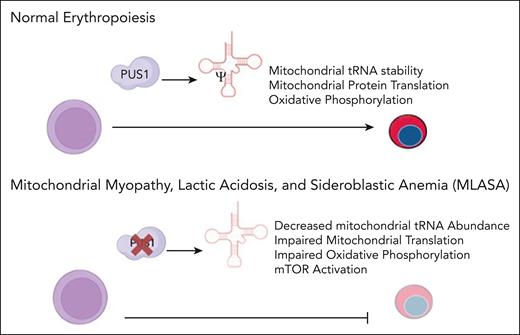In this issue of Blood, Wang et al dissect the role of pseudouridylation in erythropoiesis,1 providing clinically relevant insights into the mechanisms that underlie the inherited anemia known as mitochondrial myopathy, lactic acidosis, and sideroblastic anemia (MLASA; see figure).
During normal erythropoiesis, the conversion of uridine to pseudouridine in transfer RNAs (tRNAs) by PUS1 promotes mitochondrial tRNA stability and regulates protein synthesis rates and mitochondrial function. In MLASA, mutations in PUS1 lead to loss of mitochondrial tRNA pseudouridylation and a subsequent decrease in mitochondrial tRNA abundance, which impairs erythropoiesis through dysregulated protein synthesis, disruption of oxidative phosphorylation, and activation of the mammalian target-of-rapamycin pathway.
During normal erythropoiesis, the conversion of uridine to pseudouridine in transfer RNAs (tRNAs) by PUS1 promotes mitochondrial tRNA stability and regulates protein synthesis rates and mitochondrial function. In MLASA, mutations in PUS1 lead to loss of mitochondrial tRNA pseudouridylation and a subsequent decrease in mitochondrial tRNA abundance, which impairs erythropoiesis through dysregulated protein synthesis, disruption of oxidative phosphorylation, and activation of the mammalian target-of-rapamycin pathway.
MLASA is associated with a broad spectrum of clinical features. Anemia and lactic acidosis are hallmarks of the disease, which can be severe enough to require long-term transfusion. The myopathy often presents later and has a variable course, even within the same family, with some patients having mild myopathy and others experiencing progressive muscle weakness that culminates in respiratory failure. Additional features of the disease can include failure to thrive, cardiomyopathy, chronic diarrhea, microcephaly, and developmental delay.2 MLASA is associated with mutations in the gene pseudouridine synthase 1 (PUS1),3 which converts uridine to pseudouridine after it has been incorporated into RNA. Pseudouridine is the most abundant modification of cellular RNA and plays a key role in RNA stability and function. Patton et al demonstrated that patients with PUS1 mutations lack pseudouridine in their transfer RNAs4; however, the mechanisms by which loss of this broadly expressed enzyme results in anemia has remained poorly understood.
Wang et al identified a novel frameshift mutation in PUS1 in a patient with a MLASA phenotype. Using induced pluripotent stem cells derived from the patient, as well as a murine model harboring the frameshift mutation, they demonstrated that PUS1 loss impairs mitochondrial function and blocks erythroid differentiation. Analyses of PUS1-deficient cells revealed dysregulated protein synthesis, with a global increase in the rate of translation but decreased mitochondrial protein synthesis. These changes were accompanied by a decrease in the abundance of several mitochondrial transfer RNAs that are PUS1 targets and altered translation of proteins essential for oxidative phosphorylation. Both the murine and human PUS1-deficient cells also showed evidence that the mammalian target-of-rapamycin (mTOR) signaling pathway was activated, and mTOR inhibition with rapamycin improved erythroid differentiation in both models. Notably, rapamycin treatment also resulted in a sustained improvement in the anemia of this patient with MLASA. Together these findings suggest that PUS1 loss impairs erythropoiesis at least in part through mTOR activation, and that the mTOR pathway is a potential therapeutic target for MLASA.
The mTOR signaling pathway links nutrient availability with cellular growth and protein synthesis. During erythropoiesis, this pathway regulates both the proliferation of erythroid progenitors and the terminal maturation of erythroid precursors,5 and is critical for the response to iron deficiency.6 Precise control of mTOR activity is needed for efficient erythropoiesis. mTOR inhibition results in microcytic anemia and forced activation results in macrocytic anemia.6 The improvement in erythroid differentiation of PUS1-deficient cells observed by Wang et al after rapamycin treatment occurred without rescuing mitochondrial function and is consistent with the need for exquisite control of mTOR activity during erythroid differentiation. The mechanisms by which PUS1 loss leads to mTOR activation in erythroid cells remains a key question. The authors found that PUS1 deficiency activates mTOR in part through disruption of oxidative phosphorylation and inhibition of complex III activity. Further studies deciphering whether PUS1 deficiency activates mTOR through additional mechanisms will be of great interest and may identify additional therapeutic targets.
A mature red blood cell contains approximately 260 million hemoglobin molecules.7 The requirement for high-level globin production creates an incredible demand for protein synthesis and makes erythroid cells uniquely sensitive to perturbations in translation. Protein synthesis must be tightly coordinated with availability of iron and other nutrients, and a growing body of literature implicates mTOR signaling in the regulation of this process.5,6 Multiple inherited and acquired anemias have defects in protein synthesis and altered mTOR activity, including Diamond-Blackfan anemia and chromosome deletion 5q myelodysplastic syndrome.8 Altered mTOR activity has also been identified in β-thalassemia, where mTOR inhibition can improve erythroid differentiation by promoting gamma-globin synthesis and decreasing globin-chain imbalance through induction of authophagy.9,10 In addition, recent clinical trials have evaluated the mTOR inhibitor sirolimus for the treatment of β-thalassemia (NCT03877809 and NCT04247750).10 The study by Wang and colleagues adds MLASA to the growing list of anemias with abnormalities in protein synthesis and altered mTOR signaling. In addition, the authors demonstrated improvement in the anemia of a patient with MLASA after rapamycin treatment. Further studies are needed to determine the safety and efficacy of mTOR inhibition for the treatment of PUS1-deficient anemia, and the applicability of targeting the mTOR pathway for treatment of other inherited or acquired anemias.
Conflict-of-interest disclosure: The author declares no competing financial interests.


